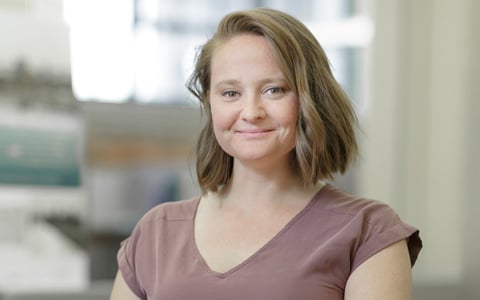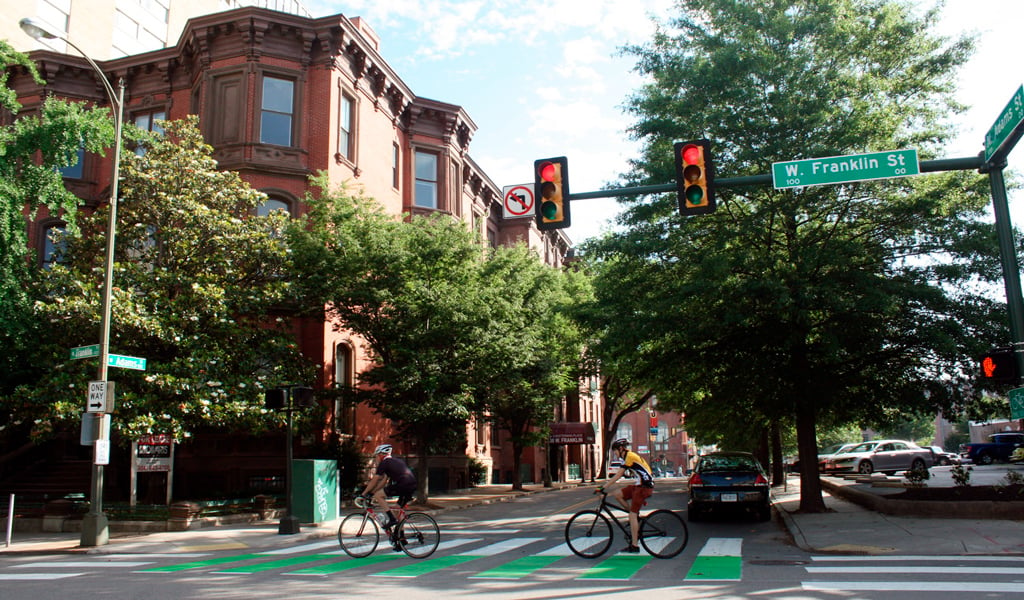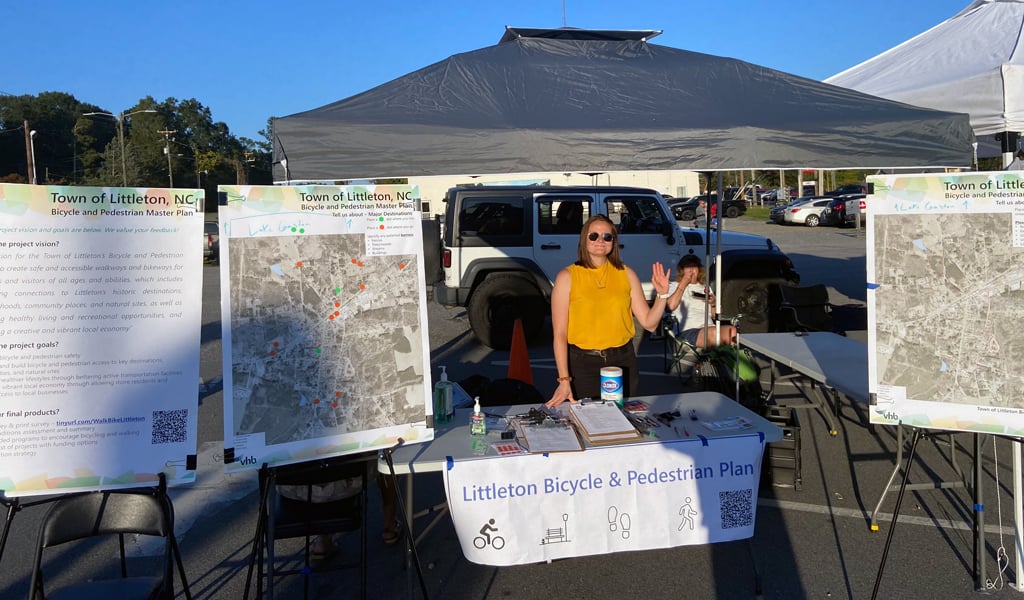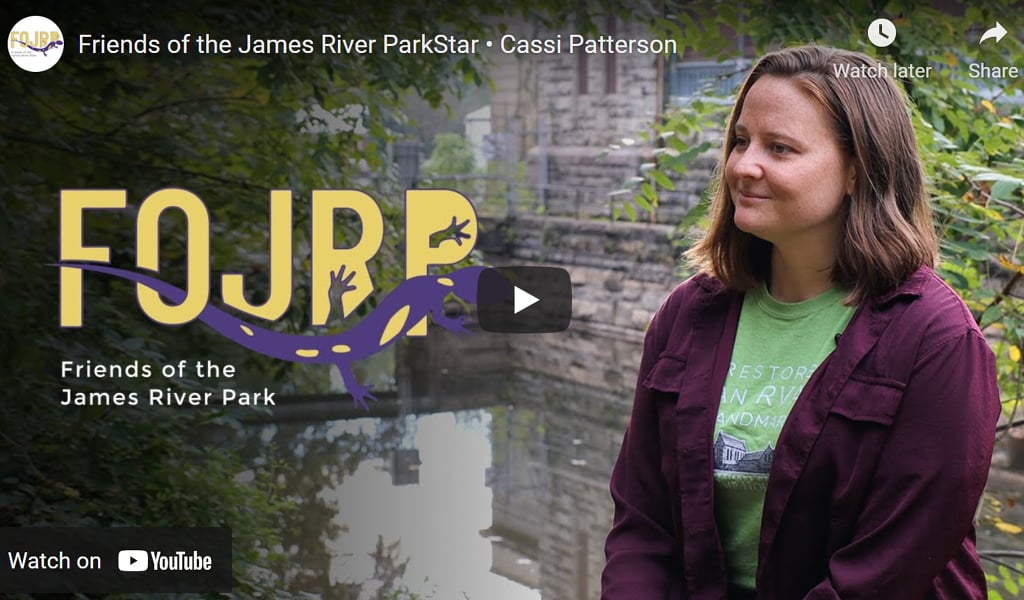
Cassi Patterson in VHB’s Richmond, Virginia, office is a bicycle and pedestrian advocate contributing to advancements in mobility within the City and beyond. Not only does Cassi spend her work hours on projects that enhance sustainability and connectivity, Cassi also actively volunteers her time to support numerous organizations with a focus on enhancing the community. Most recently, Cassi was appointed co-chair for the Safe and Healthy Streets Commission in the City of Richmond and selected as a ParkStar by the Friends of the James River Park (FOJRP). She also volunteers her time and talents with the Friends of Pump House as President, the Richmond Complete Streets Coalition, and the Richmond Planning District Active Transportation working group, which exists to make the region more bike and pedestrian friendly.
Cassi has always had a passion for the environment. It’s part of what attracted her to bicycle and pedestrian planning because she can work on projects that provide low impact transportation alternatives to reduce greenhouse gas emissions, noise pollution, and energy requirements. We talked with Cassi to learn more about her story, and how she’s shaping active mobility as an amenity in numerous communities.
Q. You devote a lot of time through your role at VHB and through volunteer efforts to advocate for bicyclists and pedestrians. Where does this passion stem from?
Cassi: There are two experiences in my life that have contributed to shaping this passion. Shortly before I graduated with a bachelor’s degree in Speech Pathology & Audiology, I went on a cross country bicycle trip from Maine to California. I wasn’t very certain that I wanted to continue the career path as an audiologist and spent a lot of this trip meditating and contemplating on my future. I knew I had a passion for biking (hence riding from Maine to California) and began to notice there were not a lot of accessible routes in a lot of the cities and towns we visited. Biking is a sustainable form of transportation, a cost-effective option, and can have numerous health benefits, but it’s not always the safest. Fast forward a few months, and I began my master’s degree in urban planning at Virginia Commonwealth University knowing I wanted to spend my career enhancing and improving the social, economic, and environmental conditions within communities to make them better.
The second experience that shaped me was on a trip to Spain as part of my coursework. During this trip I got to hear a lecture from José Garcia Cebria´n, a bike planner and activist who helped shape protected bike lane networks in multiple Spanish cities. This was the first time I heard firsthand about a role focused solely on bicycle and pedestrian networks and I thought, “I want to be that.” From there, most of my graduate coursework focused on bicycle and pedestrian planning and how the two contribute to sustainability and economic vitality in a community.

Q. How have you been able to apply what you learned through your course work and experiences abroad to contribute locally?
Cassi: One of the first projects I worked on when I started at VHB was the James River Park System Master Plan. This master plan serves as a roadmap to guide and protect the park system for the next 10 years with an emphasis on preserving the parks natural environment and creating additional opportunities for diverse groups to be able to access the park system. Through community surveys, it was revealed that 59 percent of visitors access the park by car. Part of the master plan addresses alternative, sustainable options for accessibility, such as new bus routes, trail connections, and safe access points. By offering these alternative methods of access, a larger number of people and communities will now have accessibility to an environment of nature and serenity that promote wellness and mental well-being. Like I mentioned earlier, my visit to Spain during graduate school exposed me to cities with successful multi-modal networks, including a focus on bicyclists and pedestrians. It was unique to experience cities predominately by bike that connected so many destinations, parks, and green spaces. It was my first exposure to truly seeing active mobility as an amenity and the benefits—boost in tourism, economy, quality of life for residents, and a place people want to live and work— it creates in a city of any scale.
Q. The James River Park System is a big asset to Richmond and a unique feature for the City in that it provides a natural environment so close to the urban grid. In what ways did you and the project team discover the desires of the community to incorporate that within the master plan?
Cassie: It was important to City officials and stakeholders that all people, no matter who they are or where they come from, feel welcome in the park system. Part of this project included a significant public involvement process that went where the people were that they wanted to gain feedback from. There are nine different districts within the City and there was a meeting in each district to specifically talk to each area and collect feedback about the park system. There was also a public survey as part of the process that had more than 2,300 responses. There was a lot of valuable feedback that came from these neighborhood meetings, the survey, social media outreach, and additional general public meetings. Some districts didn’t know certain parks exist, some were really focused on preserving the natural wildness of the parks, and some were interested in providing alternative ways to visit the park since parking is challenging. All of this was addressed within the plan to create an inclusive, equitable solution.
Q. The Friends of the James River Park recently selected you as a ParkStar! For those not familiar with this title, will you share with us what this means?
Cassi: Every month, the Friends of the James River Park and the James River Park System staff spotlight an individual who is actively dedicated and passionate about the James River Park. I was selected as the ParkStar for the month of November because of my involvement as President with the organization called Friends of Pump House. The Pump House Park is part of the James River Park System and the Friends of Pump House exists to preserve the historic pump house built in the 1870s that was used to get fresh water from the James River into the reservoir in Byrd Park and then into the homes in the city. There is so much more to say about this iconic structure in Richmond and you can hear all about it in this amazing video that the FOJRP put together:
Q. What are you looking forward to?
Cassi: There are a few projects I am currently working on that I am excited to see come to fruition. In Richmond, I am helping with a Road Safety Audit on Hull Street in the Southside that is focused on bettering the safety of the entire corridor, including improving pedestrian infrastructure. I am also working on a bicycle and pedestrian wayfinding program in Loudoun County, Virginia. In North Carolina, we are also working on a bicycle and pedestrian plan for the Town of Littleton, who just received a grant from NCDOT. We’ll be assisting them to develop a roadmap for connectivity through sidewalks, trails, bike lanes, and additional forms of active transportation.

Interested in learning more about how VHB integrates bike and pedestrian planning into our transportation networks? Visit the Transportation Planning & Engineering page on our website for project examples and additional service offerings.

